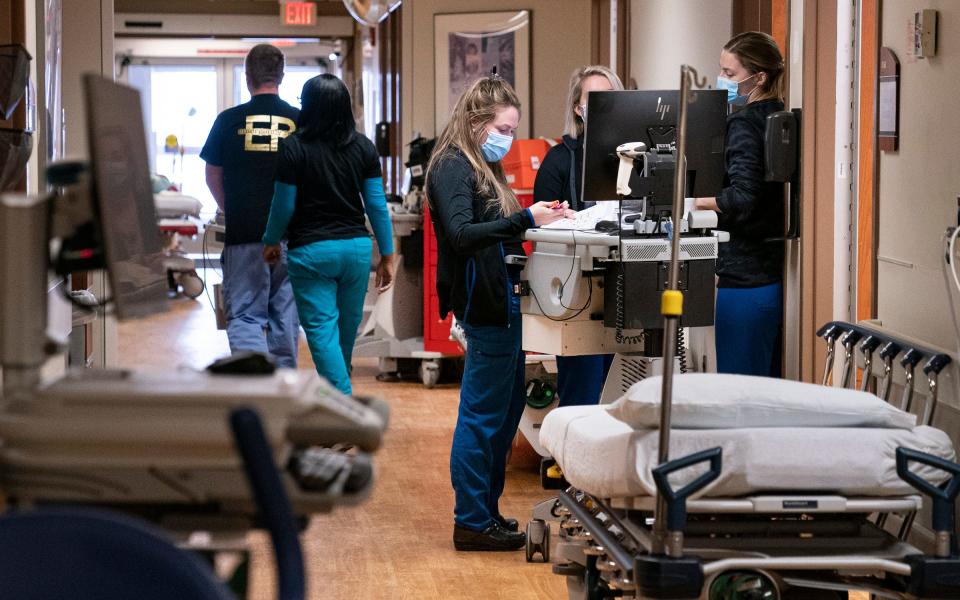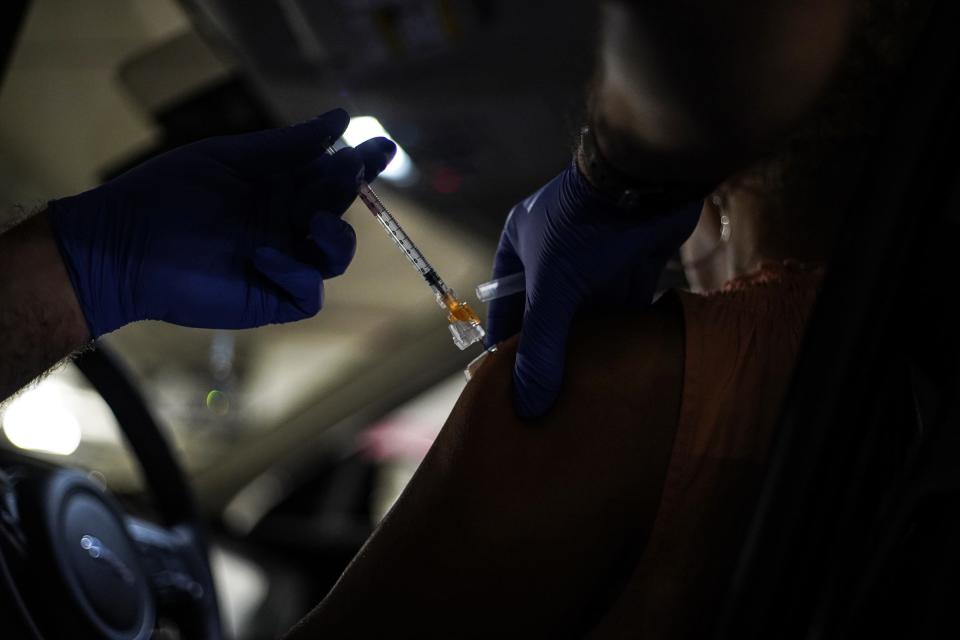Omicron BA.2 subvariant not detected in Michigan yet — but experts are concerned
It's been called "stealth omicron" and though it has yet to be detected in Michigan, there's growing concern about what this mutation of the coronavirus could mean here and across the U.S.
The BA.2 omicron subvariant evolved from the same lineage as the BA.1 omicron strain that quickly has become dominant around the world. But BA.2 has 28 unique spike protein mutations, so it's like a cousin in the family of four currently identified omicron subvariants.
Since omicron was first identified in November, it has infected nearly 90 million people worldwide in 10 weeks — more than were infected in all of 2020, said Dr. Tedros Adhanon Ghebreyesus, the director general of the World Health Organization.

More: New Michigan bill would allow controversial medications for patients dying of COVID-19
More: Meijer to offer free, at-home PCR COVID-19 tests at stores in Midwest
"We're now starting to see a very worrying increase in deaths in most regions of the world," he said Tuesday. "We're concerned that a narrative has taken hold in some countries, that because of vaccines and because of omicron's high transmissibility and lower severity, preventing transmission is no longer possible and no longer necessary.
"Nothing could be further from the truth. More transmission means more deaths. We are not calling for any country to return to so-called lockdown, but we're calling on all countries to protect their people using every tool in the toolkit."
His comments came as several European nations repealed or eased COVID-19 restrictions even as case rates rise. That's because hospitalizations aren't climbing at the same pace as cases.
Since Omicron was first identified 10 weeks ago, almost 90 million #COVID19 cases have been reported to @WHO. We are now starting to see a very worrying increase in deaths, in most regions of the world. It’s premature for any country either to surrender, or to declare victory. pic.twitter.com/mdFjaiv6sJ
— Tedros Adhanom Ghebreyesus (@DrTedros) February 1, 2022
More: COVID-19 cases among long-term care residents, staff rose in omicron variant surge
More: At Pontiac hospital, beds in the hall, a jammed ER and patients waiting in cars
"It's premature for any country either to surrender or to declare victory," Ghebreyesus said. "This virus is dangerous and it continues to evolve before our our very eyes. WHO is currently tracking four sublineages of the omicron variant of concern, including BA.2.
"This virus will continue to evolve which is why we call on countries to continue testing, surveillance and sequencing. We can't fight this virus if we don't know what it's doing. And we must continue to work to ensure all people have access to vaccines."
How prevalent is BA.2?
As of Wednesday, the BA.2 omicron subvariant was estimated to account for about 1.5% of all U.S. coronavirus cases, said Dr. Rochelle Walensky, director of the U.S. Centers for Disease Control and Prevention.
"Of course, that varies for different parts of the country," she said.

More: Michigan restaurants struggling from impact of omicron variant, study says
More: Lansing's Sparrow Hospital is 6th Michigan hospital to get federal COVID-19 medical team
In Michigan, no cases of the BA.2 subvariant had been identified through whole genome sequencing as of Thursday morning, said health department spokesperson Lynn Sutfin.
But the BA.2 subvariant has been detected in at least 57 countries and 33 U.S. states and may be circulating in Michigan even though it has yet to be discovered among the tiny portion of coronavirus tests that undergo sequencing.
All the states that border Michigan — Ohio, Illinois, Indiana and Wisconsin — have identified BA.2 cases, according to outbreak.info, which analyzes data from the Global Initiative on Sharing Avian Influenza Data, which tracks emerging variants of the virus around the world.
Why is BA.2 called stealth omicron?
Dr. Dennis Cunningham, the medical director of infection control and prevention for Detroit-based Henry Ford Health System, said calling the BA.2 subvariant stealth omicron is a little misleading.
"It's not that it's sneaky or anything like that," he said. Rapid antigen tests and PCR tests still work to detect an infection with the BA.2 subvariant.
It's just that it's not as easy to deduce from a PCR coronavirus test that it's the omicron strain rather than delta or some other variant of the virus, he said, because BA.2 mutated in a way that requires scientists to use whole genomic sequencing to determine which variant it is.
The original BA.1 form of omicron could be identified with PCR tests because one of three genetic targets was missing.
"If you had two out of the three targets, you were pretty sure it was omicron," Cunningham said of the original BA.1 omicron strain.
"They call this the stealth variant because it regained those three targets so you could no longer tell what strain it is unless you do all the sequencing."

More: Beaumont, Spectrum set to launch Michigan's biggest health system Tuesday
More: Michigan contact tracing slows down: 'Folks need to just assume they've been exposed'
That means a sample must undergo the expensive and time-consuming sequencing process, which can take more than a week to complete, to be certain which strain of the virus caused the infection.
"I don't know that people should really call it a stealth variant so much as it just mutated again and made it harder to detect it" without sequencing, Cunningham said.
Is BA.2 more contagious?
Yes, it is believed to be.
A newly published study comparing the spread of omicron's BA.1 and BA.2 subvariants in about 8,500 homes in Denmark from December and January found that BA.2 is "inherently substantially more transmissible than BA.1."
The study, which has yet to be peer-reviewed, suggests BA.2 is about 33% more than infectious than its cousin BA.1.
So that means this newest evolution of the virus is even more contagious than the original omicron, which already was considered among the most highly transmissible diseases — estimated to spread about 100 times more easily than the delta variant, said Dr. John Brooks, medical director of infection prevention for McLaren Health Care, a Grand Blanc-based health system with 15 hospitals in Michigan and Ohio.
"It does look like the BA.2 is going to kind of leapfrog over BA.1, and that already has happened in South Africa," he said.
Does it cause more severe illness?
No. The BA.2 omicron subvariant appears to cause milder disease, just like its BA.1 cousin, when compared with the delta variant and other strains of the virus.
"Although it appears to be more infectious, it's certainly isn't more aggressive because we're not seeing the hospitalizations" rise along with the rate of infection, Brooks said, in places where BA.2 is spreading rapidly, such as South Africa and Denmark.
However, that does not mean BA.2 is harmless and won't cause severe illness and death in some people.
Milder doesn't mean mild, Walensky said.
"When we look at other disease severity indicators measured among people who are hospitalized with COVID-19 — such as hospital length of stay, ICU admissions, and deaths — these indicators are lower with omicron than during previous periods of high transmission," she said last week.

"Although it's encouraging that omicron appears to be causing less severe disease, it's important to remember that we are still facing a high overall burden of disease. Hospitalizations have rapidly increased in a short amount of time, putting a strain on many local health systems."
People who are unvaccinated are at highest risk of hospitalization and death, Brooks said, even from the omicron variant.
"When I look at my ICUs (intensive care units) throughout the health system, the people that are sick in our ICUs remain the unvaccinated," he said. "They're the ones that don't have any protection at all."
Some patients who are fully vaccinated but have not had booster doses of the vaccines also have needed hospitalization, he said.
"We do have a small number of them that have come to hospital," Brooks said. "But virtually everybody that comes to the hospital who is vaccinated and not boosted ... is older with other health troubles. We've had a few boosted people end up getting admitted, but we've had nobody boosted in the ICU. So they just don't seem to be getting that sick.
"If you're vaccinated and boosted, you have really good immunity against omicron. Whether it's BA.1 or BA.2, it doesn't matter. It looks really good."
Do the vaccines work against it?
Yes, especially in people who've gotten booster shots.
A new study from the United Kingdom Health Security Agency suggests vaccine effectiveness against symptomatic illness from the BA.2 subvariant is 70%. That compares with about 63% for the BA.1, original omicron strain.
That's great news, said Katelyn Jetelina, an assistant professor at the University of Texas Health Science Center at Houston School of Public Health, in her Your Local Epidemiologist substack.
"Even though COVID-19 is getting less and less lethal on an individual-level, COVID-19 is also getting more and more transmissible," she wrote.
In the U.S., where the vaccination rate is still too low and the percentage of the population that's been boosted is still lower, omicron's lower severity is being canceled out by its high rate of transmission, she said, and "continues to make a big impact on population-level metrics, like death."

A CDC study published last week found that those who'd gotten a third booster dose of either the Moderna or Pfizer vaccines were as much as 90% less likely than unvaccinated people to be hospitalized from the virus.
"The percent of people who are currently hospitalized due to COVID-19 are disproportionately unvaccinated and disproportionately not boosted," Walensky said.
If I already had COVID-19, am I protected from BA.2?
"People who have had omicron look like they're pretty much not getting BA.2," Brooks said, noting that because the omicron strain has only been circulating since December, the past infection would have been very recent.
"It's a pretty short time frame, so they just have good natural immunity that hasn't waned or gone anywhere yet, so that makes good sense."
But not if you likely had the delta variant, alpha or any of the earlier strains, there is a risk of reinfection, especially if you haven't been vaccinated.

"We know our natural immunity to COVID wanes or goes down pretty much by four to six months in most people," Brooks said. "So if you're not vaccinated, and you've had a primary infection with one of the other ones, your immunity is probably waning and that's why people are getting omicron.
"We've had a lot of people that had COVID ... back in early 2020 and they've all gotten omicron when they're not vaccinated because their immunity has waned. It's just not strong enough to protect them any further."
Could BA.2 cause another big surge?
Maybe, but probably not, Cunningham said.
"I don't really think it's going to do anything major," he said.
"It has already really run through our population. I expect the numbers to keep going down unless there's a brand new mutation that comes up and a brand new variant."
Jetelina said BA.2 might drive a "prolonged omicron wave across many countries. For example, in South Africa cases are due to start increasing because BA.2 is taking hold. How much cases increases, though, will be important to closely follow over the next few weeks."
Are we likely to see more new variants?
"We probably will have future variants," Cunningham said.
As long as the virus continues to spread, especially among people with compromised immune systems, such as those with HIV/AIDS or autoimmune diseases, there's a risk for more mutated strains.
"We think that that's where we're getting all these new variants. It's in people with immune deficiencies who can't control the virus," Cunningham said. "It just keeps replicating and sometimes you get an unlucky mutation that makes it a little nastier.
"That's why I encourage as many people to get your booster dose as possible so we don't get these variants running through our population. And again, going to the food store, going out shopping, if we wear a mask, we could really stop this from circulating."
Could the omicron variant bring us closer to the end of the pandemic?
"We have to be totally honest that we don't know," said Dr. Anthony Fauci, director of the National Institute of Allergy and Infectious Diseases and the chief medical adviser to the president.
"We believe that we are now going in the right direction and the best-case scenario ... is that with the tools that we have — the vaccination, the boosting, the testing, the masking and all the other mitigations that we know about — when you have a level of community protection ... that we will reach a stage, and I hope it's sooner or later, when ... this will not dominate our lives.

"We can't guarantee that there will not be another variant that challenges us, but the best that we can do with that is to be prepared for it. And that's why we're doing all the things that we're doing with regard to getting better, more advanced vaccine."
A newer, more protective vaccine, along with the discovery of new treatments, Fauci said, "will be part of the armamentarium that will ultimately — even with the appearance of additional variants — get us to the point where we will not be dominated by this virus, where we can return to a degree of normality that we all crave."
"I don't think it's going to take us to the end of the pandemic," Cunningham said. "If there are future mutations that are similar to omicron, hopefully we get enough cross protection that it's over, but I just can't predict what the next mutations are going to be and if there's going to be cross protection
"What I think is going to be more likely to end this pandemic is a universal vaccine against all the coronaviruses. Most of the changes in the coronaviruses or COVID, specifically, have been in the spike protein. Different targets that are white blood cells called T-lymphocytes have not changed.
"So there are various groups around the country that are working on a vaccine that would hit those targets that aren't changing. So that's the hope, but that probably wouldn't be out for another year and a half."
Jetelina cited baseball legend Yogi Berra, saying: “ 'It's tough to make predictions, especially about the future.' And SARS-CoV-2 is making it even more difficult with its random evolutionary patterns."
Contact Kristen Jordan Shamus: kshamus@freepress.com. Follow her on Twitter @kristenshamus.
Support local journalism. Subscribe to the Free Press.
This article originally appeared on Detroit Free Press: BA.2 subvariant: What to know about COVID-19 variant of omicron

